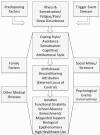Psychosocial perspectives in the treatment of pediatric chronic pain
- PMID: 22676345
- PMCID: PMC3461494
- DOI: 10.1186/1546-0096-10-15
Psychosocial perspectives in the treatment of pediatric chronic pain
Abstract
Chronic pain in children and adolescents is associated with major disruption to developmental experiences crucial to personal adjustment, quality of life, academic, vocational and social success. Caring for these patients involves understanding cognitive, affective, social and family dynamic factors associated with persistent pain syndromes. Evaluation and treatment necessitate a comprehensive multimodal approach including psychological and behavioral interventions that maximize return to more developmentally appropriate physical, academic and social activities. This article will provide an overview of major psychosocial factors impacting on pediatric pain and disability, propose an explanatory model for conceptualizing the development and maintenance of pain and functional disability in medically difficult-to-explain pain syndromes, and review representative evidence-based cognitive behavioral and systemic treatment approaches for improving functioning in this pediatric population.
Figures
Similar articles
-
Behavioural modification interventions for medically unexplained symptoms in primary care: systematic reviews and economic evaluation.Health Technol Assess. 2020 Sep;24(46):1-490. doi: 10.3310/hta24460. Health Technol Assess. 2020. PMID: 32975190 Free PMC article.
-
The experiences of acute non-surgical pain of children who present to a healthcare facility for treatment: a systematic review protocol.JBI Database System Rev Implement Rep. 2015 Oct;13(10):12-20. doi: 10.11124/jbisrir-2015-2466. JBI Database System Rev Implement Rep. 2015. PMID: 26571278
-
[Social and professional effects of hip prosthetic replacment on people under 50 years of age].Eur J Orthop Surg Traumatol. 1996 Dec;6(4):229-234. doi: 10.1007/BF03380088. Epub 2017 Mar 10. Eur J Orthop Surg Traumatol. 1996. PMID: 28315097 French.
-
[Multidisciplinary treatment program on chronic low back pain, part 3. Psychosocial aspects].Schmerz. 1996 Dec 16;10(6):326-44. doi: 10.1007/s004829600036. Schmerz. 1996. PMID: 12799844 German.
-
Family and parent influences on pediatric chronic pain: a developmental perspective.Am Psychol. 2014 Feb-Mar;69(2):142-52. doi: 10.1037/a0035216. Am Psychol. 2014. PMID: 24547800 Free PMC article. Review.
Cited by
-
The prevalence, impact and cost of chronic non-cancer pain in Irish primary schoolchildren (PRIME-C): protocol for a longitudinal school-based survey.BMJ Open. 2015 May 14;5(5):e007426. doi: 10.1136/bmjopen-2014-007426. BMJ Open. 2015. PMID: 25976764 Free PMC article.
-
Pain relief as a primary treatment goal: at what point does functioning and well-being become more important? A case study of an adolescent with debilitating chronic pain.Pain Res Manag. 2014 Jul-Aug;19(4):219-23. doi: 10.1155/2014/745458. Epub 2014 Apr 7. Pain Res Manag. 2014. PMID: 24712020 Free PMC article.
-
Do threats and reassurances reside in the biological, psychological or social domain? A qualitative study in adults and young people with chronic pain.Br J Pain. 2024 Dec;18(6):472-481. doi: 10.1177/20494637241263291. Epub 2024 Jun 24. Br J Pain. 2024. PMID: 39552922 Free PMC article.
-
Functional abdominal pain in adolescents: case-based management.Frontline Gastroenterol. 2020 Oct 19;12(7):629-635. doi: 10.1136/flgastro-2020-101572. eCollection 2021. Frontline Gastroenterol. 2020. PMID: 34917320 Free PMC article.
-
Psychological Neuromodulatory Treatments for Young People with Chronic Pain.Children (Basel). 2016 Dec 6;3(4):41. doi: 10.3390/children3040041. Children (Basel). 2016. PMID: 27929419 Free PMC article. Review.
References
-
- Perquin CW, Hazebroek-Kampschreur AJM, Hunfeld JAM, Nohnen AM, van Suijlekom-Smit LWA, Passchier J, van der Wouden JC. Pain in children and adolescents: a common experience. Pain. 2000;87:51–58. - PubMed
-
- Huguet A, Miro J. The severity of chronic pediatric pain: an epidemiological study. J Pain. 2008;9(3):226–236. - PubMed
-
- Leo RJ, Srinivasan SP, Parekh S. The role of the mental health practitioner in the assessment and treatment of child and adolescent chronic pain. Child Adolesc Ment Health. 2011;16(1):2–8. - PubMed
-
- Jones JF, Nisenbaum R, Solomon L, Reyes M, Reeves WC. Chronic fatigue syndrome and other fatiguing illnesses in adolescents: a population-based study. J Adolesc Health. 2006;35:34–40. - PubMed
-
- Johnson SK. Medically unexplained illness: gender and biopsychosocial implications. American Psychological Association, Washington DC; 2007.
LinkOut - more resources
Full Text Sources




